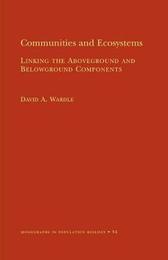
|
Communities and Ecosystems: Linking the Aboveground and Belowground Components (MPB-34)
Paperback / softback
Main Details
| Title |
Communities and Ecosystems: Linking the Aboveground and Belowground Components (MPB-34)
|
| Authors and Contributors |
By (author) David A. Wardle
|
| Series | Monographs in Population Biology |
|---|
| Physical Properties |
| Format:Paperback / softback | | Pages:408 | | Dimensions(mm): Height 216,Width 140 |
|
| Category/Genre | Ecological science
Geography |
|---|
| ISBN/Barcode |
9780691074870
|
| Classifications | Dewey:577 |
|---|
| Audience | | Professional & Vocational | | Tertiary Education (US: College) | |
|---|
| Illustrations |
58 line illus.
|
|
Publishing Details |
| Publisher |
Princeton University Press
|
| Imprint |
Princeton University Press
|
| Publication Date |
12 May 2002 |
| Publication Country |
United States
|
Description
Most of the earth's terrestrial species live in the soil. These organisms, which include many thousands of species of fungi and nematodes, shape aboveground plant and animal life as well as our climate and atmosphere. Indeed, all terrestrial ecosystems consist of interdependent aboveground and belowground compartments. Despite this, aboveground and belowground ecology have been conducted largely in isolation. This book represents the first major synthesis to focus explicitly on the connections between aboveground and belowground subsystems - and their importance for community structure and ecosystem functioning. David Wardle integrates a vast body of literature from numerous fields - including population and ecosystem ecology, ecophysiology, ecological theory, soil science, and global-change biology - to explain key conceptual issues relating to how aboveground and belowground communities affect one another and the processes that each component carries out. He applies these concepts to a host of critical questions, including the regulation and function of biodiversity and the consequences of human-induced global change in the form of biological invasions, extinctions, atmospheric carbondioxide enrichment, nitrogen deposition, land-use change, and global warming. Through ambitious theoretical synthesis and a tremendous range of examples, Wardle shows that the key biotic drivers of community and ecosystem properties involve linkages between aboveground and belowground food webs, biotic interaction, the spatial and temporal dynamics of component organisms, and, ultimately, the ecophysiological traits of those organisms that emerge as ecological drivers. His conclusions will propel theoretical and empirical work throughout ecology.
Author Biography
David A. Wardle is Professor of Soil and Plant Ecology at the University of Sheffield and has published widely on biotic interactions, biodiversity, and soil biology.
Reviews"Highly recommended for all ecologists."--Choice "I suspect that this book, if for nothing else than for the sheer weight of its intellectual synthesis, will be among [the] classics for many years to come."--Patrick Bohlen, Ecology
|